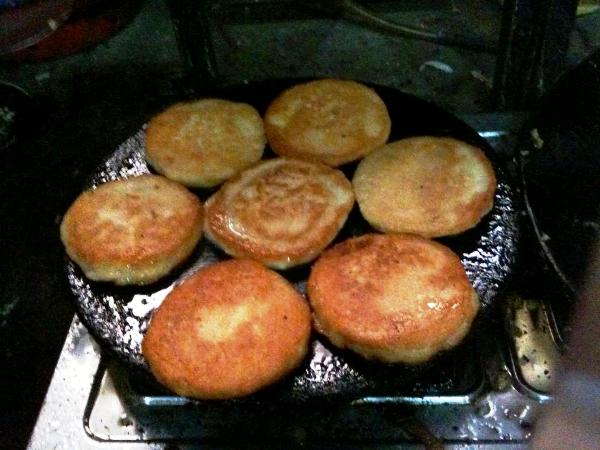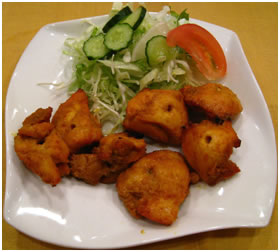Thakali Khana (Steamed Rice-Lentil Soup-Curries-Pickle set)
Momo (Dumplings)

Momo is the most popular dish, and can be found in every nooks and corners of the capital. You can ask any Nepali living abroad about the food they missed the most‚ no wonder momo will definitely top the list. Momo is basically steamed dumplings filled with minced meat and/or vegetables, herbs and spices. Momo culture probably came to Kathmandu Valley from Tibet, however Newari community transformed it as their own food using local spices and ingredients. Traditional Newari momo are generally made from buffalo meat (buff) and served with jhol achaar (kind of thin soup) made from sesame seed, tomatoes, chilies and spices. Steamed juicy buff momo served with spicy-tangy-numbing tomato and Sichuan pepper pickle is the most popular and commonly found. You can‚t leave Kathmandu without having a plate of momo or you will be missing the most delicious easy food that Kathmandu has to offer.
Samay Baji (Traditional Newari Snacks Set)

Samay Baji is an authentic traditional Newari set of dishes generally eaten during festivals or celebrations, and is also offered to gods. It can be considered as window to Newari food culture, and consists set of varieties of dishes that are believed to represent good luck, prosperity, health and longevity. It generally consists of Baji (beaten rice), Haku Chhoyla (barbecued buff meat with spices), Sanya (smoked fish), Wo (lentil pancake), Mushya Wala (roasted soybean salad), Khein (boiled egg), Aalu Wala (boiled potato salad), Wauncha (stir-fried greens/spinach), Bhuti (boiled black-eyed beans) and Lava-Palu (raw garlic-ginger), and served with Aaila (rice liquor) or Thwon (rice beer). It is perfectly balanced palate served with varieties of dishes in small portion. It is best eaten with spicy and tangy soup ‚Aalu-tama‚ made from potato, bamboo shoot and black-eyed beans, and Aila (local liquor) or Thon (local rice beer).
Chatamari (Newari Rice Crepe with Minced Meat and Egg)
Chatamari, other authentic Newari dish and also often referred as Newari pizza for foreigners, is made from thin rice batter and topped with egg and minced meat or vegetables with spices, and served with fresh tomato pickle. The best part is its thin crispy rice crepe and smoky-nutty flavor from the roasted mustard oil (one of key ingredient of Newari cooking).
Bara or Wo (Newari Black Lentil Cake)

Bara or also called Wo in Newari language is made from black lentil paste and topped with minced meat or beans/boiled potatoes (for vegetarian) with spices and egg. It is pan fried drizzled with smoky-nutty roasted mustard oil and served with either fresh tomato pickle or thick broth made from buffalo meat. You can‚t get enough of this soft-fluffy-savory pancake, and runny egg yolk even makes it better. This dish has cultural significance in Newari communities.
Yomari (Steamed Rice Cake with Sweet Fillings)

Yomari is a fluffy steamed rice cake filled with jaggery (chaku) and roasted sesame seeds, or alternatively khuwa (sweet semi-solid milk) and coconut. The jaggery and roasted sesame seed gives the cake sweet, lightly bitter and nutty flavor. This Newari delicacy is traditionally prepared during the post-harvest celebration or festival called Yomari Punhi, which falls on the full moon day in the month of December. On this full moon day, people of the Kathmandu Valley offer worship to Annapurna, the goddess of grains, for the rice harvest.
Sargemba (Blood Sausage with Wild Edible Lichen)

It is a traditional ethnic delicacy of Rai and Limbu communities, which are originally from hilly areas of eastern Nepal. This ethnic dish is only served in handful of local restaurants or eatery in Kathmandu Valley, which are run by the people from that ethnic community. Even many Nepali are not aware about this delicacy. It is blood sausage made from local pig‚s blood, minced meat, rice, spices and wild edible lichen called yangben in local language. Yangben is a rare delicacy and found to be consumed only by these ethnic communities. The sausage has very rich earthy flavor from the lichen, and melts in your mouth.
Sekuwa (Barbecued Meat with Nepali Spices)

Every ethnic communities and families have their own way of making Sekuwa (barbecued meat) and choices of meat and spices. Sekuwa is generally prepared by marinating meat with wide varieties spices and are barbecued over wood charcoal. It is generally eaten with puffed rice and achaar or pickle.
Thenthuk (Sherpa/Tibetan Noodle Soup)

Popularly know as Thenthuk, and‚ Shyakpa in Sherpa language, it is simple hearty soup prepared with freshly made noodles, meat, potato, radish, carrot, and green vegetables. It is typical dish of Sherpa and Tibetan communities living in the Himalayan region, and usually eaten during winter season or cold days. Thenthuk means hand-pulled noodles in Tibetan language. Sprinkle some Chili-Sichuan pepper (Timur) powder to spice up the dish. Other alternative widely found noodle dish is Thukpa.
Jujudhau (King of Yoghurt)

Originated in Bhaktapur (a heritage city east in Kathmandu Valley), Jujudhau literally means King of Yoghurt in Newari language. When you taste it, you will know why it is named so. I bet that you never had such delicious and creamy yoghurt before. One of the secrets of Jujudhau‚s goodness lies in culturing it in clay pot, which helps to evaporate excess moisture making it very creamy. The pot is covered with jute cloth and rice husk to maintain perfect temperature for culturing. The hint of aromatic spices like cardamom enhances the overall flavor of the yoghurt. Scooping out the top thick creamy layer is the best of all!

